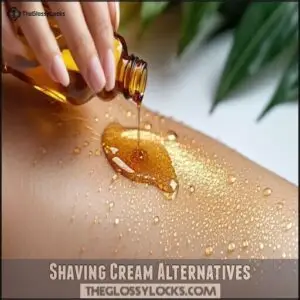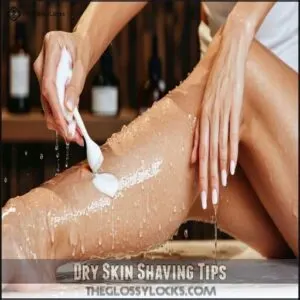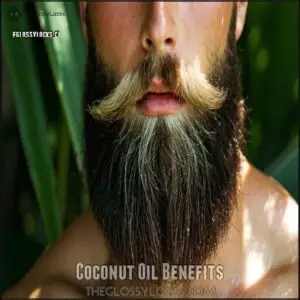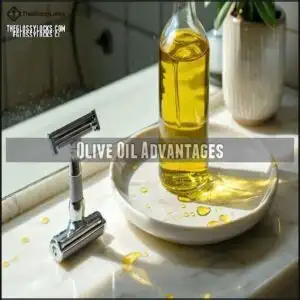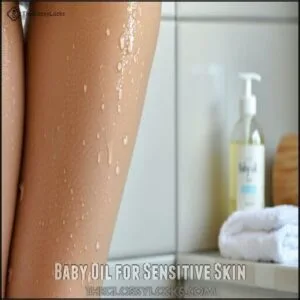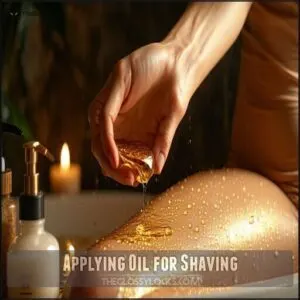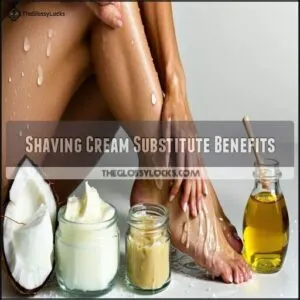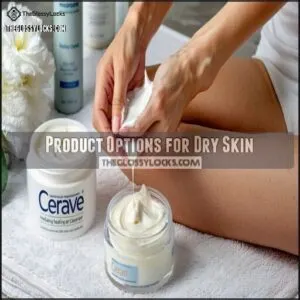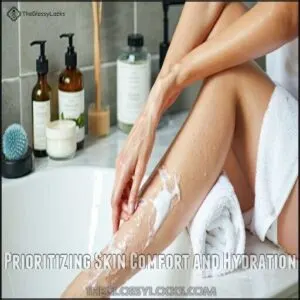This site is supported by our readers. We may earn a commission, at no cost to you, if you purchase through links.
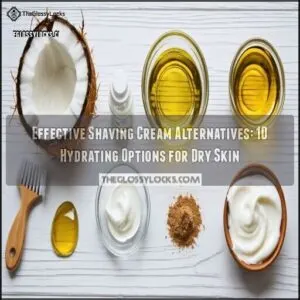
Coconut oil works wonders as a smooth operator, creating a protective barrier while hydrating.
Olive oil, honey mixed with warm water, aloe vera gel, and even hair conditioner can step in as effective shaving cream alternatives for dry skin.
Plain yogurt offers a natural lactic acid boost that softens stubborn hairs.
For sensitive types, baby oil creates a silky canvas that helps your razor glide like it’s skating on ice.
These everyday heroes don’t just replace shaving cream—they might actually leave your skin thanking you for running out, providing a natural and protective solution.
Table Of Contents
Key Takeaways
- Use natural oils like coconut or olive oil to hydrate and create a protective barrier while shaving, but avoid using them on your face if you’re prone to clogged pores.
- Aloe vera gel and baby oil are great for sensitive skin, offering smooth glide and soothing benefits without irritation.
- Avoid harsh household items like plain water or shampoo—they can dry out your skin and cause irritation during shaving.
- Prep with warm water and exfoliate gently 24 hours before shaving, then follow up with an alcohol-free moisturizer to lock in hydration.
Shaving Cream Alternatives
You’ll find plenty of effective alternatives to traditional shaving cream that won’t leave your dry skin feeling like sandpaper.
From nourishing oils to soothing gels, these substitutes create a protective barrier between your skin and razor while providing the hydration your thirsty skin craves, with nourishing oils being a key component.
Natural Oils for Shaving
Why struggle with razor burn when natural oils can transform your shaving routine?
For dry skin shaving, coconut oil offers rich hydration while olive oil delivers antioxidant benefits.
Be mindful of oil comedogenicity – coconut oil may clog pores on facial skin.
Apply a thin layer using gentle application techniques, and consider oil blending for customized benefits.
Many users find that aloe vera soothes sensitive skin.
Most natural oils offer excellent razor compatibility and built-in post-shave care, leaving your skin nourished and smooth.
Gel and Lotion Options
While oils provide excellent lubrication, gels and lotions offer outstanding hydration for dry skin shaving.
Aloe vera gel works as a natural antiseptic while creating a smooth surface for your razor to glide across.
Moisturizing lotions form a protective barrier and work well for quick touch-ups outside the shower. Both options are ideal for sensitive areas.
You can find various aloe products for different skin needs. Consider fragrance options like cedarwood for an enhanced experience, with lotion reapplication after shaving to lock in moisture.
Soap-Based Alternatives
The humble bar of soap sitting in your shower caddy can be your skin’s best friend when shaving cream runs dry.
For those with parched skin, glycerin-based shaving soaps create sufficient lather while maintaining hydration.
Natural options containing tallow, goat milk, or aloe vera offer excellent soap-based alternatives without stripping away essential oils.
Remember to rinse thoroughly and follow with moisturizer to combat potential soap dryness.
Household Items to Avoid
Many household items that seem like good shaving cream alternatives can actually damage your dry skin.
When you’re in a pinch, don’t reach for these problematic options:
- Plain water offers no protection, leading to nicks, cuts, and intensely dry skin afterward
- Harsh scrubs or products with acids strip moisture and increase irritation
- Shampoo, despite its slippery feel, contains ingredients that can irritate sensitive skin areas
Dry Skin Shaving Tips
For those with dry skin, shaving requires extra care to prevent irritation and discomfort.
Shaving with dry skin demands extra care—hydrate, protect, and soothe for a smooth, irritation-free experience every time.
Proper hydration is the cornerstone of any successful shaving routine for parched skin.
You’ll need to prepare your skin thoroughly before the razor ever touches it, ensuring maximum moisture retention throughout the process.
- Soak in warm (not hot) water for 5-10 minutes before shaving to soften hair and open pores, making dry skin solutions more effective
- Apply a gentle exfoliant 24 hours before shaving to remove dead skin cells, reducing razor drag across sensitive eczema or psoriasis areas
- Choose a razor with moisture strips and minimal blades for less irritation, as multiple blades can strip away essential oils
Your aftercare routine is equally vital – immediately apply alcohol-free moisturizer post-shave while skin remains slightly damp to lock in hydration.
Oil-Based Shaving Options
You’ll find that natural oils create a protective barrier between your skin and razor, offering superior hydration for dry skin while ensuring a smooth glide.
Coconut oil, olive oil, and baby oil are popular choices that also moisturize and provide nutrients to your skin.
Though you’ll want to use them primarily for body shaving rather than on your face where they might clog pores.
Coconut Oil Benefits
Now that you know how to prepare your dry skin for shaving, let’s explore coconut oil as a natural alternative.
This fatty-acid rich option provides deep hydration that’s perfect for parched skin.
Coconut oil’s anti-inflammatory effects help calm irritation, while its antioxidant properties protect your skin barrier.
Remember, it’s comedogenic (pore-clogging), so reserve coconut oil shaving for body use rather than facial areas.
You can even find specialized coconut oil products designed for shaving.
It’s readily available in most kitchens—a moisturizing oil solution already in your pantry!
Olive Oil Advantages
Drizzle olive oil onto your skin for a luxurious shaving experience. This vitamin-rich alternative boasts impressive antioxidant properties from vitamins E and K.
You’ll notice how it softens skin while creating a protective barrier for your razor. Though it might’ve a slightly greasy feel, warming it improves application consistency.
Discover olive oil shaving products for a specialized experience. It’s particularly effective as a shaving oil for dry skin hydration when traditional moisturizing shave creams aren’t available, providing dry skin hydration.
Baby Oil for Sensitive Skin
While olive oil brings vitamin richness, baby oil offers a gentle alternative for sensitive skin types.
This mineral oil-based option creates a protective layer that locks in skin hydration during shaving. For added comfort, consider using fragrance-free alternatives.
Here are five baby oil benefits for shaving:
- Moisturizes and protects skin during razor passes
- Reduces occurrence of nicks and razor bumps
- Creates a transparent layer helpful for precise shaving
- Works particularly well for delicate areas
- Can double as post-shave care to prevent irritation
Applying Oil for Shaving
While baby oil works wonders for sensitive areas, applying any oil for shaving requires proper technique.
For best results, warm a small amount between your palms before smoothing onto damp skin. Remember, less is more – about a quarter-sized dollop covers an entire leg.
Massage gently without rubbing in completely, creating perfect skin lubrication. This shaving cream alternative guarantees your razor glides effortlessly, leaving your skin moisturized post-shave.
Shaving Cream Substitute Benefits
You’ll find that quality shaving cream substitutes create a protective barrier between your skin and razor, reducing friction while adding much-needed moisture for dry skin.
These alternatives, from natural oils to conditioning gels, also prevent razor burn and irritation but often contain beneficial ingredients that nourish your skin during the shaving process, providing an overall improvement to your skin’s health with moisture.
Moisturizing Properties
The right shaving cream alternative doesn’t just replace your regular product—it transforms your shaving routine with superior moisturizing properties.
Transform your shave with hydration-rich alternatives that nourish, protect, and deliver a smoother, irritation-free experience.
When choosing options for dry skin, look for these hydration benefits:
- Natural oils rich in fatty acids that penetrate deeply for lasting moisture
- Ingredients supporting scar reduction and anti-aging effects
- Formulas that maintain skin’s moisture barrier during shaving
- Shaving oils that provide skin nourishment while preventing moisture loss
Lubrication and Friction Reduction
When your razor meets dry skin, it’s like sandpaper on wood—painful and damaging.
Proper lubrication creates a smooth skin barrier that reduces friction between razor and skin. Your alternative should soften hair while maintaining moisture retention.
Most shaving oils and moisturizing oils excel at this, improving razor glide substantially.
The right shaving technique combined with adequate lubrication prevents those painful nicks and cuts you’ve come to dread.
Skin Protection and Hydration
Shaving cream alternatives’ primary purpose extends beyond lubrication to creating a protective barrier between your skin and razor.
This shield prevents moisture loss during shaving while maintaining hydration levels.
Natural ingredients like aloe vera and coconut oil don’t just facilitate smooth razor glides—they actively nourish dry skin.
Always perform a patch test before full application, and don’t forget post-shave care to lock in moisture and complete your skin protection routine.
Reducing Razor Burn and Irritation
Beyond protecting your skin, proper shaving cream alternatives help prevent that dreaded razor burn. You’ll notice less irritation when using products that create sufficient glide for your razor.
For dry skin, shaving direction matters—always go with the grain first.
Post-shave care is equally important: apply alcohol-free moisturizer immediately after shaving.
Natural shaving alternatives like aloe vera both lubricate and soothe inflammation, reducing redness and irritation that often follows shaving.
Immediate relief can be found by applying cool compresses to calm irritation, providing a sense of immediate relief.
Choosing Best Shaving Alternatives
You’ll find the perfect shaving alternative when you match your skin’s needs with products that create a protective barrier between your skin and razor.
Your ideal choice should prioritize moisture-promoting ingredients that soften hair and reduce friction, allowing for a smooth, irritation-free shave.
Expert Recommendations
Dermatologists emphasize that when choosing shaving cream alternatives, you’ll want products that create a protective barrier between your skin and razor.
Testing new products on a small patch of skin first can prevent uncomfortable reactions.
For sensitive skin, experts recommend moisturizing options without irritants.
"Your shaving solution should minimize friction while providing lubrication," explains Dr. Rachel Nazarian, a board-certified dermatologist who specializes in ingredient safety and minimizing irritation.
Product Options for Dry Skin
After hearing what experts recommend, you’ll want products specifically formulated for dry skin. Cetaphil and CeraVe offer excellent hypoallergenic choices with rich emollients that won’t strip your skin’s natural moisture.
For dry skin shaving, consider these hydrating ingredients:
- CeraVe Healing Ointment with ceramides and hyaluronic acid
- Oil-based cleansers paired with damp microfiber cloths
- Thick creams containing shea butter for post-shave care
- Moisturizers with antioxidants to protect your skin barrier
Many find that witch hazel benefits can soothe redness and help with post-shave care using hypoallergenic products.
Prioritizing Skin Comfort and Hydration
After reviewing those top product recommendations, let’s consider what truly matters for your skin.
You’ll want to prioritize hydration importance above all when choosing shaving cream alternatives comparison options.
For sensitive areas, look for products with soothing ingredients like aloe.
Adjust your shaving frequency based on your skin’s response, and don’t skip post-shave care.
Remember, moisturizing shaving options aren’t just nice-to-have—they’re your skin’s best defense against the daily razor battle.
Frequently Asked Questions (FAQs)
How often should I exfoliate before using alternatives?
While gentle exfoliation helps, harsh scrubbing damages.
You’ll want to exfoliate just 1-2 times weekly before using alternatives, allowing your dry skin to maintain its natural moisture barrier between shaving sessions.
Can medication affect which alternatives work best?
Yes, certain medications can dry your skin or make it sensitive, affecting which shaving alternatives work best.
If you’re on acne treatments or retinoids, stick with gentle options like aloe vera or fragrance-free lotions.
Are DIY mixtures effective for extremely dry skin?
When your skin’s thirstier than a desert traveler, DIY mixtures can work wonders.
You’ll find honey-yogurt-olive oil blends particularly effective for your parched dermis, creating a moisture-rich barrier that’ll help your razor glide smoothly.
Do weather conditions impact alternative effectiveness?
Weather absolutely impacts your shaving alternatives.
During winter, oil-based options like olive oil work better for extreme dryness, while in humid conditions, lighter alternatives like aloe vera prevent extra stickiness.
You’ll need seasonal adjustments to ensure the best results, considering the impact of humidity on your shaving experience.
Should shaving direction change with different alternatives?
Switching shaving direction depends on the product.
Oil-based alternatives allow smoother strokes, so shave with the grain first.
Creamy or soapy substitutes work both ways, but always go lightly to avoid irritation.
It’s trial and glide!
Conclusion
Think of your shaving routine like painting on a smooth canvas—what you use matters.
With these effective shaving cream alternatives for dry skin, you’re ditching store-bought options and also treating your skin to natural hydration.
Coconut oil, olive oil, and even plain yogurt can keep dryness at bay while reducing irritation.
Remember, always test a small area first and keep skin moisturized post-shave.
Your pantry and bathroom already hold the key to softer, happier skin!

